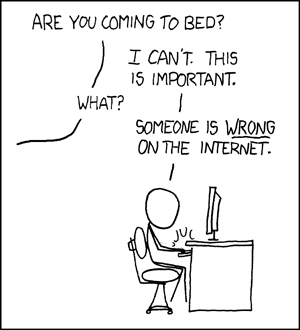Posts
-
Hillary, Google, and a Rant
CommentsTurns out the secret to getting more blog posts out of me is to royally piss me off.
There’a a viral video claiming Google manipulated search results in favor of Hillary. I’ve seen several people watch this and say, “Yeah, seems likely.” In contrast, my reaction was to laugh at the video, and I did, before I found out how many people believed it. Then I was just mad.

I may regret this, but here’s why I find the whole affair preposterous.
The Argument
While researching for a report about the last presidential primaries, SourceFed found that Google’s autocomplete suggestions for search queries involving Hillary differed from Yahoo’s and Bing’s. Google’s autocompletes were both more positive and less common than Yahoo’s and Bing’s suggestions. In contrast, a few autocompletes tried for Sanders and Trump matched across all search engines.
They then examine the relationship between Hillary and Eric Schmidt, to give Google a motive for biasing search results.
My Rebuttal
Autocompletes are Not Biased Just for Hillary

These are results found by Snopes. They have similar results for Trump. So, right off the bat it seems like the video didn’t try enough search queries.
When there is more uncertainty in what search the user is making, Google biases towards a more positive result. This is something that happens whenever the search includes anyone’s name. It hold for Sanders, and for Trump, and for Hillary, with no preference to any of them. See Google’s explanation here.
Note this is not the same as Google always having positive search results. If someone searches “Bernie Sanders so”, it’s likely it will get completed to “Bernie Sanders socialist”, since Sanders self-identifies as a democratic socialist. On the other hand, he does not identify as communist, making “Bernie Sanders communist” a rarer phrase. That’s why Google autocompletes “socialist” but not “communist”.
The only interesting thing here is that “socialist” has better sentiment than “communist”, and that it isn’t seen as an offensive enough word to avoid.
It Would Be Too Difficult to Hide The Conspiracy
Let’s set aside motive. Because actually, I don’t give a shit about the motive. I don’t care how Hillary and Eric Schmidt are related. A good motive increases the likelihood a person does something, but it doesn’t magically make that something happen.
So to play devil’s advocate, let’s ignore motive, and assume Google has been manipulating search results for Hillary. In such a world, what also has to be true?
Code acting specifically for Hillary had to be added in by a programmer. That code then made it past code review. No one on the entire search team noticed this, or anyone who did decided to stay quiet. Let’s say the team is on the order of 100 engineers. Search is a core product of Google and the company is over 50,000 employees, so I think this is a close enough guess.
This is a lot of people! And nobody acted as a whistleblower? Note that Sanders outraised Clinton in Silicon Valley, so there must be a sizable contingent of Sanders fans, who would certainly report this if it actually existed.
If the conspiracy is true, then none of those 100 engineers reported it, despite having direct access to Google’s codebase. And, despite a sizable fraction of them being Bernie supporters. AND, despite them knowing search very well because it is their literal full-time job.

This is incredibly preposterous. I’ve read many arguments for why Google would bias their autocomplete results, but I’ve yet to see anyone explain how a company could hide a conspiracy to influence the presidential election. Scandals are really, really hard to cover up - think of how many government scandals the public finds out about.
The Part Where I Go Off The Rails and Rant and Maybe Piss People Off
I could stop this post here, because all I needed to do was cast reasonable doubt on this video. But just for kicks, let me explain why I got trolled into writing this post.
SourceFed claims the conspiracy was so subtle that they only realized it after all the presidential primaries ended. Why? Why now, instead of after other big election days? It could be random chance, but I have another explanation.
Here’s my claim: while Bernie had a chance at becoming the nominee, people focused on ways Bernie could win. Once Bernie lost in California, instead of grieving in silence, they turned to finding reasons Bernie deserved to win. Because that’s how the narrative goes! The system is corrupt, it’s fighting against the One True Candidate at every turn. It doesn’t even have to be a conscious decision, a subconscious bias towards believing Bernie was cheated makes people susceptible to ballooning a small difference in autocomplete results into the extraordinary claim that Google is in cahoots with Hillary. They didn’t ask if their evidence was strong enough to back their claim, because it fit the storyline.
This is symptomatic of a trend I’ve noticed among the most intolerable Bernie supporters. I am not talking about the Bernie supporters who like his policies and really wanted him to win the nomination. The majority of Bernie supporters I interact with are reasonable people who don’t let their love for Bernie blind themselves from the realities of the situation.
No, I’m talking about the die hard fans. The ones who have deified Bernie practically to the level of the Second Coming. Here comes Bernie Sanders, our Lord and Savior, descending from the mountaintops of Vermont! Wielding pen and paper, he’ll fight the establishment at every turn! Where establishment = exactly every part of politics working against Bernie Sanders.
To these people, the idea that Hillary won because a large percentage of voters agreed with her platform is ridiculous. Instead, they’d prefer to believe Hillary bought all her votes, as if everyone who voted for her was a mindless drone or sheep. Because she’s establishment, and establishment is evil. Establishment is the bane of our existence. They are the Enemy, they hold all the keys. Whoever the establishment backs wins, which is why the two nominees are Hillary Clinton and Jeb Bush. YEP. THAT IS DEFINITELY WHAT HAPPENED.
Believing the system is corrupt is fine. Wanting to decrease money’s influence in politics is an admirable goal. Voting for a candidate you believe in is the whole point of democracy. And grieving when a candidate loses just shows how much you cared about electing the person you believed would make the world a better place.
But if you’re going to revel in tribalism, if you’re going to shift the boundaries whenever it lets you avoid getting mad about something you like, or if you’re going to decide someone’s intelligence based on which candidate they like, I will find it very hard to respect you. I will find it very hard to tolerate you. If you refuse to be civil in debates, I will ignore you.
In contrast, if you understand that people are messy, political beliefs are a maze of dead ends, and arguments where people respect each other are doable, then holy shit, we should keep in touch.
If you can’t do that? Well, then no. We shouldn’t keep in touch. It’s not worth my time, and you’ll find plenty of people to get mad at instead of me.
Oh, and if you make a conspiracy video with horrible justification, I’ll feel free to laugh at you. It’s not nice, in fact it’s downright mean, but I find it a hell of a lot easier than thinking about a world where people will believe something because an eight minute video pandered to them in the right way.

-
The Blogging Gauntlet: May 31 - Conclusion
CommentsThis is part of The Blogging Gauntlet of May 2016, where I try to write 500 words every day. See the May 1st post for full details.
I’ll be honest, I expected to feel a lot different after this month than I actually do.
Perhaps that’s my bias from stories about One Big Revelation That Changes Everything. The kind of turning point that people use when writing memoirs.
It doesn’t feel like I changed that much. Maybe there was a big change, but it’s only something I can recognize after the fact. In the now, the me of yesterday is too familiar, and the me of two days ago is still fresh in my mind, and both of these “me”s are too similar to the current me. It’s too hard to see the accumulation of subtle shifts, if there were any.
What went well, and what didn’t? For starters, writing 500 words every day was both less and more time consuming than expected. Some of my posts were written under an hour, which is stupidly fast for me. That happened because on some days I only had an hour…
If you do it at the last minute, it only takes a minute.
(Anonymous Berkeley professor)
However, some posts took over four hours. Hopefully, this is just because of work ballooning to fill my free time, of which I had a lot of this month, and it won’t take me that long to write once I start working full-time.
For something that went poorly, writing about a new topic every day was and is too much for me. There are quite a few posts that I genuinely regret writing. The ideas backing them are either ill-formed or nonexistent, but I was forced to use them in the name of daily posts. I have blog-worthy ideas more often than once every two weeks, but less often than every day.
I could have avoided this by dedicating more than one post to a given topic, and in fact was expecting to do so, but that ended up falling apart. I’m simply not familiar with the serial mindset of posting part after part of a whole. When I write, I like to rearrange paragraphs and ideas all over the place, until I get an ordering I like. This stops working in serial writing. Publishing the beginning of a post fixes the ideas I start with and the order they are presented in, and trying to continue from a bad start is awful. I have on occasion scrapped entire drafts when I realized I wasn’t writing about what I actually wanted to write about, and if I had published the start of those drafts, I would have been forced to continue topics I disliked. I know serial writing is doable, it’s just that I can’t do it yet.
On to what went well. I managed to write a post every day, only missing the deadline once. The money cost worked as planned, because it gave me impetus to write posts even when I could have justified skipping a day. After enough writing, I learned blogging was something I wanted as a regular part of my life, and the potential penalty of losing twenty dollars diminished in importance. It still mattered, but it wasn’t the only thing that mattered.
I flushed most of my blogging idea queue. The only ideas left are ideas that require tons of introspection (meaning they had to take more than a day) and ideas that require tons of planning. I hope to get the planning ones out soon, or at least start the introspection/planning process.
I have a better appreciation for doing a little bit each day. I may try to incorporate similar thinking into tasks that are inherently long term, like learning a new language.
I successfully beta-tested posts I’ve always wanted to write, and although not all of them worked out, some were very well received, more than I expected them to be. Getting to write in a context where people knew they shouldn’t expect something perfect was a big help.
On that note, this is where you, the reader, come in. This has been a journey for me, and I could use more detailed feedback. If you could fill this quick survey, I’d appreciate it - it’ll directly contributes to making this blog better.
Next steps: going to stop blogging for about a week because I’m technically on vacation, then I’ll start working on longer posts and/or rewriting posts from this month that I liked. I’m thinking about adding an update schedule, but need time to think about the details. In either case - stay tuned.
-
The Blogging Gauntlet: May 30 - Welcome to the Medium
CommentsThis is part of The Blogging Gauntlet of May 2016, where I try to write 500 words every day. See the May 1st post for full details.
If you don’t know who Alan Moore is, let me tell a story.
Alan Moore is one of the most influential comic writers of all time. Among his works is Watchmen, which I consider to be a masterpiece. It’s visually rich, thick with plot and symbolism, and has an all around engrossing narrative.
Alan Moore is also known for having very strong opinions about adaptations of his work. Moore has without fail hated adaptations of his work, so much so that he refuses to be listed in the credits of those adaptations. The one exception is the Justice League Unlimited adaptation for “The Man Who Has Everything”.
So, when a Watchmen movie was announced, his response was typical - he refused to see it and did not want to be credited. However, his reasoning was interesting.
There are things we did with Watchmen that could only work in a comic, and were indeed designed to show off things that other media can’t.
(Entertainment Weekly)
I haven’t found a quote by Moore where he explains this, but here’s a fan explanation I quite liked. Watchmen uses tons of visual callbacks, and lots of visual motifs. An entire chapter is palindromic for pete’s sake. It’s rich enough that sometimes you want to pause and take in all the detail.
A comic lets you do this, but a film doesn’t. A film pushes images at you frame after frame. It dictates the pace of each scene. In contrast, when reading a comic, the reader chooses how long they spend on each page. Comic time can be stretched or contracted or made to run backwards if the reader wishes it to be. When Dr. Manhattan talks about determinism and seeing all times at once, it can be interpreted as a commentary on comic readers themselves. It doesn’t work as well in a movie because the subtext disappears.
Just as there are differences between comics and movies, there are differences between books and movies. William Goldman wrote the book The Princess Bride, then later adapted it into the movie people endlessly quote. What’s striking is how different the plot is between the two. The book has a deeper backstory on Inigo Montoya’s father. It has a more elaborate framing device, where instead of a grandfather telling a story it’s an unhappily married man rewriting a story his father told him in his youth. Goldman didn’t have to change anything since he wrote his own adaptation, but he did. Why?
Let me take a stab at why movies have fundamentally different storytelling standards. A book has a much easier time doing inner monologues. The author is allowed to write each character’s inner thoughts. By contrast, a movie’s goal is to show, don’t tell. The viewer expects the director to make full use of the images and audio, and that expectation places limits on what kinds of dialogue are acceptable. I’ve heard this is very clear in the Hunger Games adaptations, which have to cut out lots of Katniss’s inner monologue.
The choice of medium influences the kind of stories you can tell. In extreme cases you get things like Watchmen, but even in normal cases different mediums have different strengths and weaknesses. Things hosted online like this blog are pressured to be more casual and readable, because it is super easy for the reader to get distracted, meaning you need a very casual flow of information. That’s good for discussion and bad for concentrated learning. Stories in print are given more leeway, while films are pressured to make sure no one gets lost if they miss a single minor detail.
The title is a reference to Homestuck, a webcomic (kind of) that could only work on the Internet. By incorporating text, animated GIFs, Flash animations, and interactive games, it creates what can only be called an experience. If Watchmen is arguably unadaptable, Homestuck is definitively so.
Another example is Undertale. The game simply would not work if the player was not given the choice between Spare or Kill, making it a story that works best as a video game. Any other medium wouldn’t give that choice. (There are spoilery reasons for why a Choose Your Own Adventure book wouldn’t work either.)
Next time you see something interesting, try considering through what means it was presented, and see if it colors your perception. If you find anything interesting, leave me a comment, since I’d like to learn more.